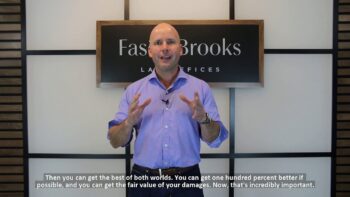
Q: How can a law firm give the best possible service to its clients?
A: By getting them the best possible settlement as quickly as possible.
At Fasig & Brooks, we have developed a strategy we call our “Full Court Press,” which we have designed to achieve justice for our clients in the shortest possible time. The strategy involves utilizing the leverage of the litigation process and capitalizing on the insurance companies’ fear of bad faith claims. We use this strategy when it becomes apparent to us that the value of our client’s damages is greater than the available insurance policy limits. We put pressure on the insurance company to settle for its policy limits and increase the pressure until the company relents. If the insurance carrier fails to pay the limits before treatment progresses and the medical bills rack up, we then have the opportunity to shift gears and pursue an excess judgment and bad faith claim. In other words, if the insurance company makes an unwise decision not to tender the limits when given an opportunity to do so, we can, under Florida law, pursue a bad faith claim and hold the insurance carrier liable for the full amount of our client’s damages, regardless of the limits set out in the policy. The fear of a bad faith claim should be, and often is, a strong motivator for an insurance carrier to tender the limits quickly. There are several steps we take to maximize the power of this strategy, and I’m going to lay out the essential elements in this post.
Why is it important to move quickly to settle personal injury cases under many circumstances? Because money is being spent from the moment a claim is opened. If there is a limited amount of insurance funds, we prefer the money to go into our clients’ pockets, as opposed to toward legal and medical costs. Legal work involves expenses, which ultimately come out of the client’s recovery. Many of the legal expenses could be avoided with a quick settlement. Medical treatment also involves expenses, which could come out of a client’s recovery. If a health insurance carrier pays medical bills before a settlement, the carrier is entitled to reimbursement of the money spent. That reimbursement comes out of the settlement, reducing the amount of money that goes into our client’s pocket. On the other hand, if health insurer pays after the settlement, the carrier is not entitled to reimbursement. As a result, a fast settlement often results in significantly more money in our client’s pocket.
STEP ONE: EVALUATE THE AVAILABLE INSURANCE COVERAGE
The first step of the full court press strategy is to properly evaluate the case in relation to the available insurance coverage. (From our perspective, settlements should be fair to both sides. Swift justice is the goal.) This strategy is only advisable when the insurance coverage is not enough to cover the full amount of the plaintiff’s damages. For instance, if you have a clear liability automobile accident case with significant property damage, and a herniated disc with no prior injuries, and only $25,000 in coverage, you know it’s time to use the full court press strategy. An insurance carrier who balks at settling a case like that for the policy limits deserves to suffer the consequences of a bad faith claim. The reality is that a large percentage of our cases involve damages that exceed the policy limits. The other reality is that insurance companies are often slow to acknowledge the full value of a claim, and sometimes never acknowledge it until a jury awards a verdict or even later.
STEP TWO: SEND A QUICK DEMAND LETTER
Once we realize our client’s case is worth more than the available insurance coverage, we send what we call a quick demand. A quick demand is a letter to the insurance company giving them an opportunity to settle for the policy limits. Most attorneys settle their cases by utilizing what we call a full demand. The full demand is a letter that goes to the insurance company along with all of the relevant records, bills, and other materials that justify payment of the policy limits. A quick demand, on the other hand, is a letter that goes to the insurance carrier along with HIPPA compliant releases, allowing the insurance carrier to gather the relevant records and bills. We send quick demands because it cuts out the time it takes for us to gather the records and bills, and puts pressure on the insurance carrier to gather the records and bills within a certain time period or risk the possibility of acting in bad faith. An insurance carrier has a duty to investigate a claim within a reasonable time frame. Failure to do so can be considered bad faith. A quick demand gives the insurance carrier a date by which the policy limits must be tendered; I usually give them 45 days from the date of the letter. It gives the carrier a list of all relevant medical providers, as well as HIPPA compliant releases, allowing the carrier to retrieve records from all relevant providers. It’s very important to include a list of all prior medical records for the last ten years, because failure to be completely forthcoming with all relevant evidence could kill a bad faith claim.
The quick demand explains why the case is worth more than the policy limit, detailing the damages and expressing the worst possible scenario for the client. For instance, if the client has a herniated disc, we may write in the demand, “The client suffers from a herniated disc which could lead to lumbar fusion or decompression surgery.” This way, if the case doesn’t settle and it turns out that our client does need surgery, we can argue that we put the carrier on notice of the potential for surgery early on but the carrier chose to ignore the risk. The quick demand also suggests that if the carrier chooses not to tender the limits, the carrier should recommend the insured defendant obtain independent counsel to protect the insured’s interest. If the carrier fails to make that recommendation after being advised to do so, this is more evidence the carrier is acting in bad faith. When an insured defendant hires independent counsel, the insurance carrier feels additional pressure to tender the limits to protect the insured and avoid a bad faith claim.
Almost inevitably, when I send a quick demand, the carrier writes a letter or calls, asking for additional time to evaluate the claim. I always respond by asking how much time, and if the carrier is reasonable, I grant the extension. Failure to do so could result in the carrier using the “set up” defense in a subsequent bad faith claim. Essentially, carriers often argue that the plaintiff’s lawyer was trying to set them up for bad faith and they didn’t have enough time to investigate. The idea here is not to set the carrier up for bad faith; it is to persuade the carrier to tender the policy limits as quickly as possible. If the carrier fails to do so when it should, the carrier is setting itself up for a bad faith claim.
STEP THREE: FILE A LAWSUIT AGAINST THE DEFENDANT
To avoid an inevitable “set up” defense, and to continue putting pressure on the carrier to pay the policy limits, I usually give the carrier a second chance to pay the policy limits, even after the time frame for my quick demand has expired. This is part of the full court press strategy. I file a lawsuit against the defendant and have the defendant served with process. Along with the lawsuit paperwork, I include a cover letter, instructing the defendant to forward the paperwork to the carrier. I also attach a copy of a letter to the carrier wherein I offer again to settle for the policy limit. I give the carrier until the date the answer is due, which is twenty days from the date of service of process. I state that failure to tender the policy limits will put the insured defendant at risk for an excess judgment. Again, I state that if the carrier chooses not to pay the policy limit the defendant should obtain independent counsel. This puts the carrier in the position where the adjuster has to explain to the insured defendant why the carrier is not protecting him or her by paying the policy limits. It also puts the carrier in a position where it has to hire defense counsel to defend the claim. It makes no sense for a carrier to hire defense counsel to defend a claim which ultimately results in a policy limits tender. This often results in the carrier taking a closer look at the case and calling to tender the policy limits before hiring defense counsel.
STEP FOUR: FILE A NOTICE FOR TRIAL
The next step in the full court press strategy is to file a notice for trial as soon as we receive all Answers to our Complaint. I have found that an impending trial date is the number one motivating factor to make insurance carriers evaluate claims fairly. A lot of plaintiff’s lawyers think you have to wait twenty days from the date you receive the answer, but a careful reading of the Rules of Civil Procedure reveals that you can notice a case for trial as soon as you receive Answers from all defendants. If a lawyer waits twenty days unnecessarily, it will take twenty days longer for the case to resolve, which means the client is waiting around for twenty days longer because the lawyer didn’t act quickly enough. By filing a notice for trial and pushing as hard as possible for the earliest possible trial date, we put the maximum amount of pressure on the carrier to tender the policy limits.
Inevitably, when a notice for trial is filed, the judge will require the parties to go to mediation to resolve the claim. Here’s my recommendation: set the earliest mediation possible, and if the case is really worth more than the policy limits, stick to your guns at mediation. Do not settle for less, because the carrier will recognize you mean business and will most likely tender. Meanwhile, 91 days after service of process, file an offer of judgment for the policy limits. An offer of judgment is a formal offer through the court system that puts enormous pressure on defendant carrier’s to tender the policy limit. You can’t file the offer of judgment until 90 days after service of process. If the carrier fails to pay the policy limits within thirty days of the filing of an offer of judgment, the defendant will be responsible for paying not only compensatory damages in excess of the policy limit, but also the plaintiff’s attorney fees and costs. If the carrier foolishly fails to pay the policy limits after being given multiple opportunities, as described above, they are vulnerable for a bad faith claim.
STEP FIVE: BE WILLING TO GO TO TRIAL
My last piece of advice for attorneys who want to get more policy limits settlements is to try the cases where the carrier foolishly failed to pay the limits and your client wants to go to trial. Too many lawyers are afraid to go to trial. When the carriers get wind that you are willing to try a case, the settlement values of all your cases will increase. You might lose some, but you will probably win some too, and the carriers will be much more likely to tender the policy limits early on cases where they see you as the attorney. Since we implemented the full-court press strategy, our average case value has more than doubled. It doubled because we are using all of the leverage available to us, and we are willing to try cases.
I hope this article helps other plaintiff attorneys obtain fast and full valued settlements for their clients.
ABOUT THE AUTHOR:
Jimmy Fasig is the managing partner of Fasig Brooks and has won numerous million and multimillion-dollar recoveries on behalf of clients. With nearly two decades of legal experience, he intimately understands Florida personal injury law and is dedicated to providing injured victims with the best possible legal representation.






